Utilization Of Cassava, Soybean Meal And Soyhulls By Swine
Introduction And Background
Swine production in Thailand has developed tremendously in the past two decades. At present, only
high performing animals are raised commercially. These high performing animals are more prone to
stress and have lower ability to digest low quality feed. They require not only a higher nutrient density
diet but also a diet with better digestibility and lower crude fiber level.
Soybean products, composed of soybean meal and extruded fullfat soybeans, have become major protein sources in animal diets since they are high in protein and essential amino acids, low in crude fiber, and are easily available. However, most soybean meal available to farmers in Thailand is not dehulled and has a fiber content of around 7%. This has contributed to a higher overall level of fiber in the diet.
Oil crushers in Thailand have recently started to produce dehulled soybean meal. Soy hulls are removed before the oil extraction process. This dehulling process has made dehulled soybean meal and Soy hulls available to swine producers. The purpose of the study is to investigate the benefits of using dehulled soybean meal and soyhulls in pig diets.
Cassava or tapioca (Manihot esculenta Crantz) is an important tropical perennial root crop, which is widely grown in Southeast Asia, Africa and Central America. The plant is adaptable to wide varieties of soil types, resistant to drought, and requires minimum attention to obtain an acceptable yield. Cassava is one of the most efficient plant for starch deposition and can yield 20 - 60 tons of fresh root per hectare in 10 - 12 months depending on the breeds and fertilizer application. The fresh starchy tubers contain approximately 60% moisture and are mainly utilized for the production of cassava starch for human food and industrial uses, and dried cassava chips and pellets are for animal feeds.
Thailand ranks third in fresh cassava root production in the world and is world leader in tapioca product exports. The country produces 18 - 20 million tons of fresh cassava roots annually, half of which is processed into starch and the rest converted into chips and pellets for animal feed.
Cassava pellets had been the major export to the EU market. The decline of cereal prices in the EU has lowered the price and the quantity of cassava pellets exported to that market, thus severely affected the price of cassava roots and the entire cassava industry of Thailand. As a result, promoting cassava use in animal diets in Thailand was proposed and implemented by Animal Nutrition Research and Development Center, Kasetsart University, Kampaengsaen, Nakhon Pathom, Thailand, with the assistance of Thai Tapioca Development Institute. Seminars and workshops on the utilization of cassava for animal feeds were conducted for farmers around the country and a number of research was done to demonstrate the suitability and the advantages of using cassava in animal nutrition.
Results of the activities have dramatically increased the utilization of cassava in animal diets in Thailand. Juttupornpong et al., (2004) did a survey on utilization of cassava in animal production and feed industry in Thailand in 2002-2003 and reported that cassava has been widely used in pigs, dairy and beef cattle feeds both at the feed mills and farms levels. Application of cassava in broilers feed is limited but the potential is promising. The estimated volume of cassava used has increased from less than 0.2 million tons in 1997 to more than 1.0 million tons in 2002. Cassava is now widely accepted as an alternative basal feed ingredient in every type of animal diets.
The research studies and the practical field application of cassava diets by farmers and feed mills in Thailand have clearly demonstrated that cassava is not only a basal feed ingredient that can be totally substituted for cereals i.e. corn, broken rice in diet of pigs (weaner, grower, finisher and breeder), poultry (broiler, layer and ducks), beef and dairy cattle as well as aquaculture, but it acts as a functional feed ingredient that could improve the health and disease resistance of the animals (Kanto and Juttupornpong, 2004). The beneficial effects are derived from the fact that cassava is highly digestible starch, contains very low to no mycotoxins, the presence of natural lactic acid bacteria and yeast, and the low content of HCN. Results of studies have shown that starch in cassava is highly digestible and well digested in the upper part of the small intestine which have provided beneficial effects on the growth of nonpathogenic bacteria, decreased the pH and decreased the population of pathogenic bacteria i.e. E. coli in the digestive tract of the animals. Cassava contains no or very low level of mycotoxins. The acidic pH of cassava chips and pellets as well as the presence of Lactobacillus spp. on cassava chips and pellets have prevented growth of mold on the products. HCN content in cassava has prevented mycotoxins development by mold and has stimulated peroxidase system in the animal body, which has a beneficial effect on the destruction of myctoxins molecules absorbed into the animal body.
Mycotoxins have many adverse effects on animal growth, production and immunity development. Cassava diets seldom showed any signs of mycotoxin toxicity thus making cassava an ideal feed ingredient. Natural contamination of lactic acid bacteria and yeast in cassava have altered the natural micro flora in the digestive tract of animals in favor of non-pathogenic bacteria. This has reduced the pH and lowered the number of pathogenic bacteria in the intestine of animals. The activation of the peroxidase system by thiocyanate derived from HCN in cassava will not only destroy the aflatoxins molecule but also reduces number of microorganisms including pathogenic microorganisms in the animal body and milk. A recent study has shown that laying hens on cassava diet supplemented with leucaena leaves meal or cassava leaves meal has significantly higher laying percentage and significantly lower mortality rate than those on corn diet supplemented with the same leaves meal, especially when all animals were infected by avian influenza disease at the peak of the production (Sataratananan et al., 2004). This shows that cassava has the property of a functional feed ingredient that will improve health and disease resistance, while maintaining the performance and productivity of the animals.
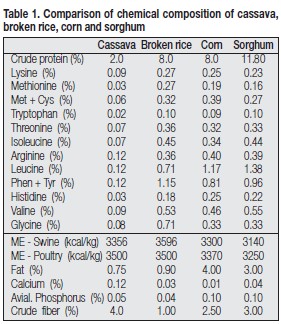
Cassava Nutrient Content
The chemical composition of cassava compared
to corn, sorghum and broken rice is shown in
Table 1. In general, cassava is a source of energy
and contains very low protein (approximately 2
%) and low amino acids, when compared to the
other ingredients. The cassava products are also
low in fat and contain no pigments. It is necessary
therefore to compare the nutritional values of
cassava products with that of cereals i.e. corn.
Cassava – corn equivalent mixture (CCEM) is a combination of cassava, SBM and synthetic amino acid to raise the protein and amino acids levels equivalent to that of corn. In general, a CCEM which is a mixture of 0.87 kg of cassava + 0.13 kg of soybean meal (SBM) + 0.001 kg of DLmethionine would have crude protein, amino acids and ME equivalent to 1 kg of corn. Prices of the CCEM at different prices of cassava and soybean meal are shown in Table 2. For convenience, one can figure out the feasibility of using cassava in animal diets by converting the local prices of corn, cassava and soybean meal into U.S. dollars (USD) to make a comparison. Although prices of DL-methionine and vegetable oil will be different in different countries, the cost of the ingredient accounted for only approximately 10% of the total cost of CCEM, thus making the table more applicable to every situation. The CCEM formulation contains no pigment and an additional cost of natural or synthetic pigment need to be added when the CCEM is used in poultry diets.
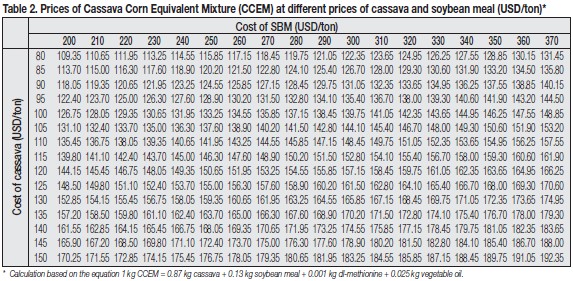
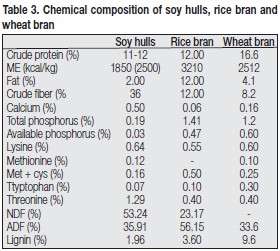
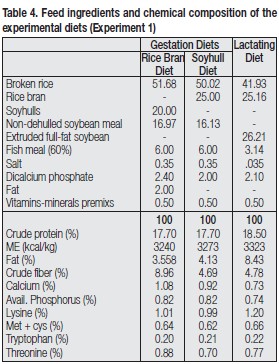
Experiment 1
Effects of soyhulls on performance of
gestating sows and litters of lactating sows
The experiment was conducted at a commercial
farm in Nakhon Pathom Province from May to
August, 2003. A total of 100 sows, on second,
third and forth parity were divided into two groups of 50 sows each. They were kept individually in
gestating pens where feed was provided twice daily and water was provided ad libitum. The sows
were randomly selected and fed with a control diet and a soyhull diet during the gestation period.
Diet 1: Control diet - broken rice – dehulled soybean meal - fish meal - 25% rice bran.
Diet 2: Soyhull diet - rice bran in Diet 1 was substituted with 20 % soyhulls.
The diets were given to the sows after conception (no return of estrous) at 1.5 kg daily for the first 80 days of pregnancy and increased to 2.0 kg daily at the last 30 days of pregnancy. Both groups of animals were fed ad libitum with the same lactating diet during the nursing period. Feed ingredients and chemical composition of the experimental diets in gestation and lactation periods are shown in Table 4.
Birth and weaning weights as well as litter size at birth and at weaning, and feed intakes of the sows during lactation were recorded. The data were evaluated for analysis of variance, and the difference among means were determined by T-Test (SAS, 1989).
Results and discussion
Effects of soyhulls in the diet of gestation sows on performance and litters during lactation are shown
in Tables 4, 5 and 6. The results show that there were no significant differences in litter size at birth and
weaning, birth weight and weaning weight of the piglets and feed intake of the sows fed with soy ull
and rice bran diets (see Table 5). However, sows fed on the soyhull diet (Diet 2) produced larger sized
litters at weaning (even though the litter size was smaller at birth) and the difference was around 0.5
piglets per litter. Sows on the soyhull diet (Diet 2) consumed more feed during the lactation period,
allowing them to produce more milk, thus improving the survival rate of the piglets.
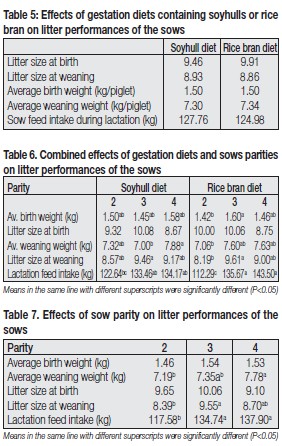
Higher intake of feed during lactation can be explained by the fact that the soyhull diet was quite bulky and able to absorb water. This instant increased the bulk density after several consumptions. The consumptions caused an enlargement of the digestive tract during gestation and facilitated more feed consumed during the lactation period.
Combined effects of gestation diets and parities of the sows are shown in Table 6. There were some significant (P<0.5) differences in the performance of the litters at different parities. On the whole, there was no significant difference in the performance of the piglets in litters produced from sows fed rice bran (Diet 1) or soy hulls (Diet 2).
Effects of parity on performance of the litters were significant as shown in Table 7. There was no significant difference in birth weight and litter size among the sows at different parities. Sows on parity 4 had significantly (P<0.05) higher weaning weight than those on parity 2. Piglets of the sows on parity 3 had significantly higher (P<0.05) weaning weight than those of the sows on parity 2. Sows on parity 3 and 4 had significantly higher (P<0.05) feed intakes than those in parity 2.
Conclusion
There were no significant differences in birth weight, weaning weight, litter size at birth and at weaning as well as feed intake of sows on rice bran and soyhull diets. However, sows on a soy hull diet had higher feed intake during lactation and produced larger litter size at weaning by approximately 0.50 piglet/litter.
This can be explained by the fact that bulkiness of a soyhull diet and its high water absorption capability increased digestive tract capacity of sows, thus facilitating increased feed consumption and more milk production during the lactation period. Soyhulls can be used at 20 % inclusion rate in the gestation diet to give better results compared to rice bran diet.
Experiment 2
Effects of dehulled soybean meal on weaned pig diets
The study was conducted at a commercial pig farm in Nakhon Patom province during the period of
May-June and August-September, 2003. A total of 128 three-way crossbred (LWxLRxD) weaner pigs
aged 28 days were divided into four groups of 32 animals each. Each group was divided into four
sub-groups of eight piglets each. They were kept in 2x2 meter battery metal cages where feed and
water were provided ad libitum. Each group was randomly fed one of the trial diets as shown below
until 58 days of age.
Diet 1: Control - broken rice-non-dehulled soybean meal-fish meal diet.
Diet 2: Dehulled soybean meal replaced non-dehulled soybean meal in Diet 1.
Diet 3: Control – cassava - non-dehulled soybean meal - fish meal diet.
Diet 4: Dehulled soybean meal replaced non-dehulled soybean meal in Diet 3.
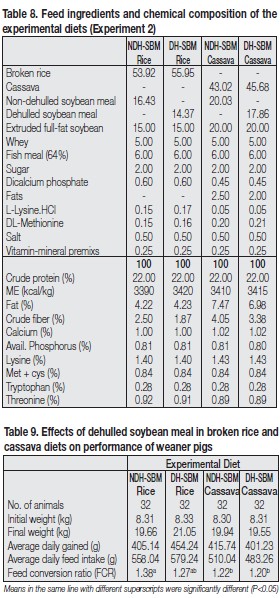
Each diet was formulated according to the nutrient requirement of the weaner pigs recommended by Kanto (1994). Feed ingredients and chemical compositions of the diets are shown in Table 8. The feeds were pelletized before feeding to the animals. Initial weight, final weight, and feed intake of the animals were recorded. Average daily gain and feed conversion ratio were calculated.
Data were evaluated for analysis of variance. Differences among the means were determined by Duncan’s New Multiple Range Test (SAS, 1989).
Results And Discussion
Effects of dehulled soybean meal on performance
of weaner pigs fed either broken rice or cassava
diets are shown in Table 9. There were no
significant differences in average final weight,
average daily gain and average feed intake of the
animals on the experimental diets. Pigs on cassava
diets using non-dehulled soybean meal and
dehulled soybean meal had significantly better
(P<0.05) feed conversion ratio than those on the
broken rice diets. Pigs on broken rice-dehulled
soybean meal had higher average final weight
(7%), higher average daily gain (11.21%) and
better feed conversion ratio (8%) than those on
broken rice-non-dehulled soybean meal diet
although the differences are not significant.
Lower fiber content and the more concentrated protein and amino acids in the dehulled soybean meal were responsible for the improvement in performance. Lower crude fiber content of the diet not only improved the digestibility of the dry matter but also the protein and amino acids in the feed as well. The use of dehulled soybean meal in the cassava diet produced poorer average final weight, average daily gain, and average daily feed intake than those on the cassava-nondehulled soybean meal diet although the differences were not significant. However, the cassava-dehulled soybean meal diet resulted in a better feed conversion ratio although the differences were not significant.
Based on the above results, cassava-based weaner pig diets, may need a higher inclusion rate of soybean products. Since calculation of the feed formulae was based on the book value of dehulled soybean meal, it is possible that the actual nutrient contents of the dehulled soybean meal used in the study were lower than the standard book value.
This may have caused a nutritional deficiency especially amino acid deficiency to the animals. DLmethionine supplementation in the cassava-dehulled soybean meal diet could improve the performance.
Conclusion
Dehulled soybean meal and broken rice diets had beneficial effects on the performance of weaner
pigs when compared to non-dehulled soybean meal diets. The dehulled soybean meal and cassavabased
diet did not show a very clear advantage. This can be explained by the fact that nutrient
content of dehulled soybean meal used may be lower than the book value that was used in the
calculation. Therefore this may have led to a deficiency in amino acids, especially methionine, in the
animals fed on the dehulled soybean meal-cassava diet. To validate this assumption, a repeat of the
trial is needed where a higher level of methionine is added.
Experiment 3
Effects of substitution of soyhulls for rice bran in corn and cassava based growingfinishing
pig diets
The study was conducted at the experimental animal housing of the Animal Nutrition Research and
Development Center, Kasetsart University, Kampaengsaen, Nakhon Pathom, Thailand from May to
September, 2003. A total of 96 three-way crossbred pigs (LWxLRxD) weighing 25 kg were divided
into four groups of 24 animals each. Each group was further divided into six sub-groups composed
of three males and three females of four animals each. They were kept in 1.5x4.0 meters solid concrete
floor pens where feed and water were provided ad libitum. Each group was randomly fed one of the
following trial diets until they reached 90 kg body weight.
Diet 1: Control - corn-dehulled soybean meal - fish meal - 15% rice bran.
Diet 2: Rice bran in diet 1 was replaced with 15% soy hulls.
Diet 3: Control – cassava - dehulled soybean meal - fish meal -15% rice bran.
Diet 4: Rice bran in diet 3 was replaced with 15% soy hulls.
Each diet was formulated according to the nutrient requirement of the animals recommended by Kanto (1997). Feed ingredients and chemical compositions of the diets are shown in Tables 10 and 11.
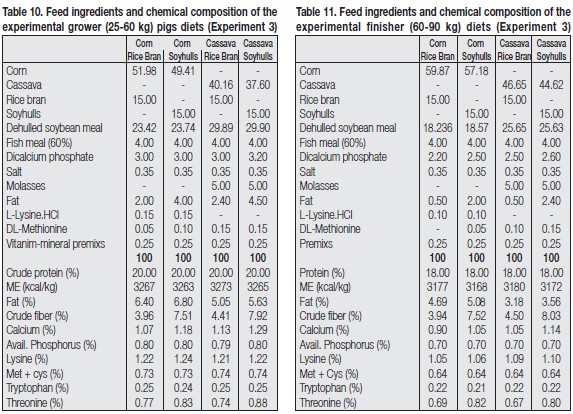
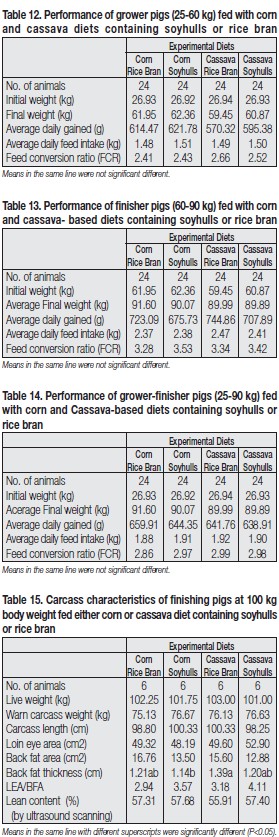
The diets were in mash form. Initial weight, final weight and feed intake of the animals were recorded. Average daily gain and feed conversion ratio were calculated. Data were used for analysis of variance calculation. Differences among the means were determined by Duncan’s Range Test (SAS, 1989).
Effects of substitution of soyhulls for rice bran in grower (25-60 kg), and finisher (60-90 kg), and on corn and cassava-based diets are shown in Tables 12, 13 and 14. There were no significant differences in final weight, average daily gain, average daily feed intake and feed conversion ratio of growing pigs fed with corn or cassavabased diets containing soyhulls or rice bran (Table 12). However, pigs fed with corn and cassavabased diets containing soyhulls tended to have better final weight, average daily gain and average feed intake than those on rice bran diets, although the differences were not significant.
There were also no significant differences in the final weight, average daily gain, average feed intake and feed conversion ratio of finishing pigs fed with corn or cassava-based diets containing soyhulls or rice bran (Table 13). However, animals on soyhulls diets tended to have lower final weight, average daily gain, average daily feed intake and feed conversion ratio than those on the rice bran diets, although the differences were not significant.
In the growing-finishing period, there were no significant differences in the average final weight, average daily gain, average feed intake and feed conversion ratio of the animals fed either on corn or cassava-based diets containing soyhulls or rice bran (see Table 14). It is important to note that soyhulls used in the study were not cooked and had a high level of trypsin inhibitor, which inhibited protease activity in the digestive tract of the animals. The low feed intake of the grower pigs resulted in the low intake of trypsin inhibitor and caused no effect on performance of the animals. The study shows that performance of animals on soyhulls diets are not significantly different from those on the rice bran diets, indicating that soyhulls were utilized by the animals.
Carcass characteristics of animals fed the experimental diets are shown in Table 15. There were no significantly differences in carcass length, loin eye area (LEA), back fat area (BFA), LEA/BFA ratio and lean percentage among animals fed the experimental diets. However, there was a clear trend that pigs on either corn or cassava diets that contained soyhulls trended to have larger LEA, lower BFA and better ratio of LEA/BFA than those on the same diets but containing rice bran. Pigs on the diets containing soyhulls had significantly less (P<0.05) back fat thickness than those containing rice bran.
Soyhulls clearly improved carcass quality of the animals in this study. The higher crude fiber content of the soy hull diets (Diet 2 and 4) may be responsible for the lower back fat thickness and the larger LEA of the animals than those on the diets containing rice bran. It is also worth to note that fiber in soyhull has improved carcass quality without any adverse effect on growth rate and feed conversion ratio of the animals. This shows that the fiber in soyhulls was well utilized by the animals. Use of pelleted commercial soyhulls with a minimum level of trypsin inhibitor should provide better result than those found in the study and should provide a satisfactory performance in commercial pig production.
Conclusion
1. Soyhulls could substitute for rice bran at a 20 % inclusion rate in gestating sow diets without any
adverse effect on the reproductive performance of the animals. Use of soyhulls in the gestating
sow diet has the advantage of increasing the litter size at weaning and feed intake during the
lactation period.
2. Soyhulls could substitute for rice bran at a 15 % inclusion rate in corn or cassava-based grower and finisher pig diets without any adverse effect on the performance of the animals. However, uncooked soyhulls used in the study resulted in poorer performance in the finisher period. This is due to the higher feed intake, hence higher trypsin inhibitor intake of the animals. Cooked soyhulls are therefore recommended.
3. Dehulled soybean meal has resulted in a greater improvement in weaner pig performance when included in broken rice-based diets. The use of dehulled soybean meal in cassava-based diets in weaner pigs produced slightly poorer results than non-dehulled soybean meal cassava-based diets. This is probably due to an under estimation of the nutrient content of the dehulled soybean meal used in the study, thus causing an imbalance in nutrients in the cassava-based diet. Further study will be required to confirm this assumption.
4. Pigs on either corn or cassava diets that contained soyhulls had larger LEA, lower BFA and better ratio of LEA/BFA than those on the same diets containing rice bran. Pigs on the diets containing soyhulls had significantly lower (P<0.05) back fat thickness than those on the same diets containing rice bran.
Animal Nutrition Research and Development Center and Department of Animal Science,
Kasetsart University, Thailand
and Cheong Yock Loon, American Soybean Association, Singapore
Tags · Utilization Of Cassava · Soybean Meal And Soyhulls By Swine


cassava leaf protein is fair in lysine content.
Write a comment
* = required field